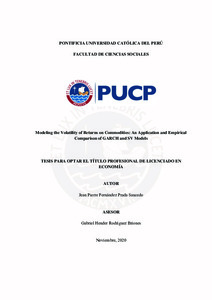Modeling the volatility of returns on commodities: an application and empirical comparison of GARCH and SV models
Abstract
Seven GARCH and stochastic volatility (SV) models are compared to model empirically
the volatility of returns on four commodities relevant for South America economies: gold,
copper, oil, and natural gas. Our results show that SV models outperform GARCH models
on average. We find that the best-performing return volatility models are: GARCH-t for
gold, SV-t for copper and oil, and SV with leverage effects (SV-L) for natural gas. The
inclusion of fat tails and jumps components largely raise the performance of GARCH
models, while this contribution is less for SV models. Even, SV models with jumps are
usually outperformed by the basic SV model. We also find evidence of a leverage effect
in oil and copper, resulting from their dependence on world economic activity; and of an
inverse leverage effect in gold and natural gas, consistent with the former's role as safe
asset and with uncertainty about the latter's future supply. Additionally, in most cases
there is no evidence of an impact of volatility on the mean or MA-type first order
autocorrelation.
Temas
Precios--Modelos econométricos
Inversiones--Modelos matemáticos
Productos básicos--Precios--Modelos econométricos
Acciones (Bolsa)--Modelos econométricos
Inversiones--Modelos matemáticos
Productos básicos--Precios--Modelos econométricos
Acciones (Bolsa)--Modelos econométricos
Para optar el título de
Licenciado en Economía
Collections
The following license files are associated with this item:






